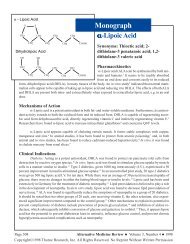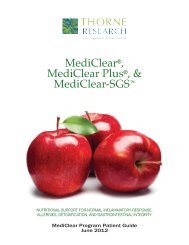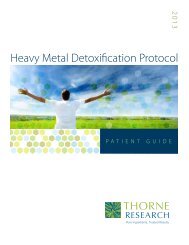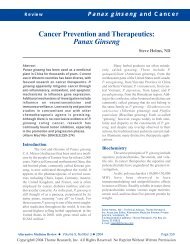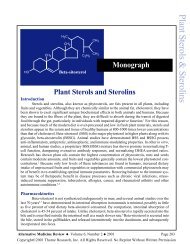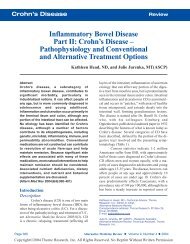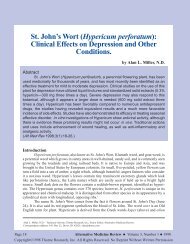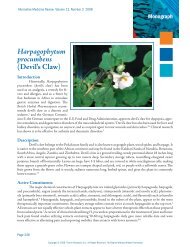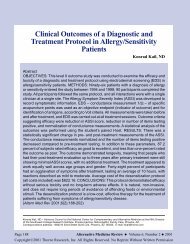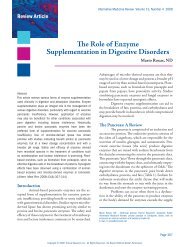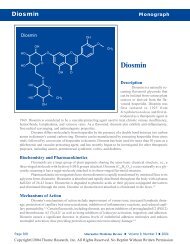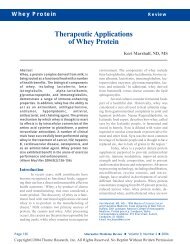Inulin-Type Prebiotics â A Review: Part 1 - Alternative Medicine ...
Inulin-Type Prebiotics â A Review: Part 1 - Alternative Medicine ...
Inulin-Type Prebiotics â A Review: Part 1 - Alternative Medicine ...
Create successful ePaper yourself
Turn your PDF publications into a flip-book with our unique Google optimized e-Paper software.
<strong>Review</strong> Article<br />
<strong>Alternative</strong> <strong>Medicine</strong> <strong>Review</strong> Volume 13, Number 4 2008<br />
article on prebiotics: “a selectively fermented ingredient<br />
that allows specific changes, both in the composition<br />
and/or activity in the gastrointestinal microflora that<br />
confers benefits upon host well-being and health.” 2<br />
Definitions of prebiotics typically have in common<br />
an emphasis on the compound being non-digestible (and<br />
hence subject to colonic enzymatic activity and fermentation<br />
by colonic bacteria) and able to selectively stimulate<br />
the growth of one or more desirable or health-enhancing<br />
types of gut bacteria. While definitions of prebiotics do not<br />
emphasize a specific bacterial group, the number and/or<br />
activity of Bifidobacteria and other lactic acid-producing<br />
bacteria must be increased for the compound to qualify<br />
as a prebiotic. Either implicitly or explicitly within most<br />
definitions is the concept that the compound improve the<br />
health of the subject consuming it.<br />
While many nutritional compounds have<br />
some degree of prebiotic activity, Roberfroid identified<br />
two groupings of nutritional compounds that met his<br />
definition, inulin-type prebiotics and galactooligosaccharides<br />
(GOS). 2<br />
Other nutritional compounds suggested as<br />
prebiotics, but not included by Roberfroid as prebiotics,<br />
include gentiooligosaccharides, glucooligosaccharides,<br />
isomaltooligosaccharides, mannan oligosaccharides,<br />
N-acetylchitooligosaccharides, oligosaccharides from<br />
melibiose, pectic oligosaccharides, xylooligosaccharides,<br />
gums (like gum Arabic), hemicellulose-rich substrates,<br />
resistant starches (such as resistant maltodextrin),<br />
lactosucrose, oligodextrans, polydextrose, germinated<br />
barley, gluconic acid, glutamine, lactose, and the simple<br />
sugar tagatose (a mirror image of fructose). 2-5 Because<br />
research on several of these compounds for prebiotic activity<br />
is promising, it is possible that in the future one or<br />
more of these compounds might also meet the criteria<br />
specified in Roberfroid’s definition of prebiotics.<br />
This review article will focus on one of the two<br />
subcategories of prebiotics Roberfroid included in his<br />
definition – inulin-type prebiotics. This grouping was<br />
selected because they represent the most widely commercially-available<br />
prebiotic compounds. <strong>Part</strong> 1 of this review<br />
defines inulin-type prebiotics, explores food applications,<br />
and examines their ability to modulate gut microflora. In<br />
part 2, studies examining the use of inulin-type prebiotics<br />
as a therapeutic option will be reviewed.<br />
<strong>Inulin</strong>-type prebiotics include inulin, oligofructose,<br />
and fructooligosaccharides (FOS), oligo- or<br />
Figure 1. GF 2<br />
Fructan<br />
Glucose α(1–2)<br />
Fructose<br />
β(2–1)<br />
Fructose<br />
polysaccharide chains comprised primarily of linked<br />
fructose molecules that are bifidogenic. <strong>Inulin</strong>-type prebiotics<br />
are used as functional food ingredients in beverages,<br />
yogurts, biscuits, and spreads; they are also used as<br />
dietary supplements.<br />
<strong>Inulin</strong>-type prebiotic compounds are naturally<br />
occurring constituents in many plants. Root vegetables<br />
including Jerusalem artichokes, burdock, chicory, leeks,<br />
and onions are especially rich sources. Estimates suggest<br />
a person consuming an average North American diet ingests<br />
1-4 g inulin-type prebiotic compounds daily, a low<br />
daily intake compared to a less processed diet, higher in<br />
plant foods. It is also considered low compared to other<br />
regions of the world, such as Europe, where estimates<br />
suggest an average daily intake of 3-11 g. 6<br />
General Chemical Structure of <strong>Inulin</strong>type<br />
<strong>Prebiotics</strong><br />
<strong>Inulin</strong>-type prebiotics are members of a larger<br />
group called “fructans.” Fructans represent a category of<br />
compounds that encompasses all naturally occurring<br />
plant oligo- and polysaccharides in which one or more<br />
fructosyl-fructose linkages comprise the majority of<br />
glycosidic bonds; hence, they are primarily polymers of<br />
fructose units. Fructans can have at least one fructosylglucose<br />
linkage – identical to that found with sucrose<br />
and, when present, is typically a starting link in the<br />
polymer chain. When the starting molecule is sucrose in<br />
the fructan chain, the bond between the starting glucose<br />
and the second carbon (of fructose) can be hydrolyzed<br />
to some degree by sucrase enzymes, secreted by the tips<br />
of the small intestinal epithelial villi, and produce free<br />
glucose. The presence of this sucrose sugar moiety is not<br />
a necessary precondition for the compound to be considered<br />
a fructan; therefore, many fructans begin with<br />
fructose. Structurally, fructans can be linear or branched<br />
fructose polymers.<br />
Page 316<br />
Copyright © 2008 Thorne Research, Inc. All Rights Reserved. No Reprint Without Written Permission.



